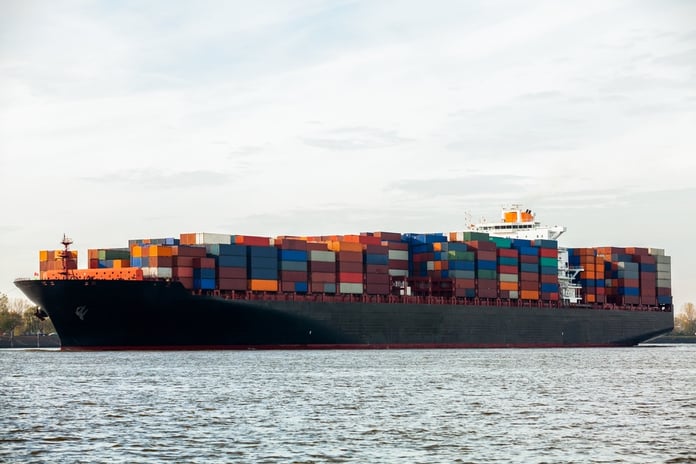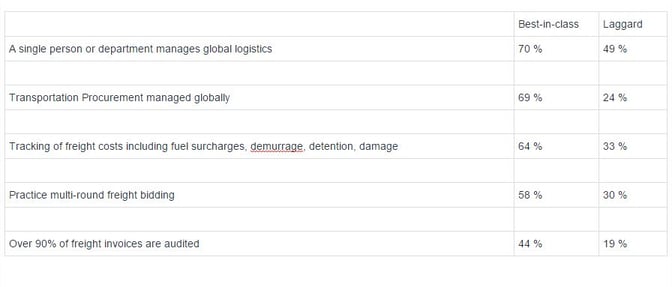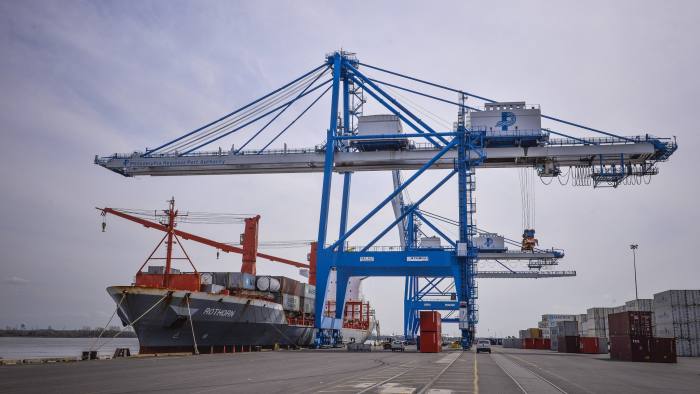The buzz today is all about controlling ocean freight costs. Profit margins are under pressure, so it's important to know if your carrier is invoicing at the contracted rates, or if fuel surcharges are appearing mysteriously on their invoices to you. You may also want to make sure that LCL shipments are not combined in order to give you FCL rates. Checking the transit times is equally important; goods-in-transit are being financed; it's important to get them delivered and sold.
Table Of Contents
Common Factors in Best-In-Class Shippers
Ocean Freight Rates Statistics: A Holistic Approach to Freight Spending
Moving Beyond Manual Audits To Automation
The use of data has percolated through every aspect of transportation and supply chain spend management--from ground transportation and air to the ocean freight industry. Compared to years ago, shippers now have many more tools and benchmarks to gain visibility into carrier performance. These tools impact shippers’ spend management goals and ensure they are getting what they paid for--that carriers are performing to their contractual and service level agreements (or not, as the case may be).
Yet many shippers still don’t track or benchmark ocean carriers’ performance or implement key performance indicators (KPIs)--putting themselves at risk from carrier underperformance, less-than-stellar service and even supply chain disruptions.
Why is this lack of strategic spend visibility a less-than-ideal business practice for you, if you’re a shipper, 3PL or freight forwarder who’s trying to optimize your spend?
It’s no secret that the ocean freight industry’s profit margins are under extreme pressure. If you’re not using freight procurement data or benchmarking options to track ocean freight carrier performance, you’re essentially operating blind. So it’s doubly important to be aware of how exactly carriers’ economic imperative impacts how they are invoicing you:
- Are carriers actually using your contracted rates?
- Do fuel surcharges appear mysteriously on invoices?
- Are LCL shipments combined into the invoice, for lower FCL rates?
- Do you know your carriers’ transit times?
Related reading: Digital Fitness: A Prerequisite for Logistics Success

Common Factors In Best-In-Class Shippers
Management of profitable shippers is cognizant of these issues, and sets a corporate tone that logistics, or logistics management, is to be considered an important segment of management planning. About 5 years ago, the Aberdeen Group identified the following common factors in companies they considered “best-in-class” shippers. Though, you may say that the report is dated, it actually still holds true today. These companies featured in the study ensured that their carriers were:
- 45% were compliant in their contract costs
- 7% were compliant in their routing requirements
- 71% decrease their freight costs annually (per unit carried)
In the same study, Aberdeen identified the following factors in those companies they considered laggards. These shippers seemed to take less interest in their freight costs because they felt:
- 45% of their carriers were compliant in their contract costs
- 8% of their carriers were compliant in their routing requirements.
- 65% reduction in their freight costs annually (per unit carried)
These stats clearly indicate that shippers and freight forwarders are still operating on a tactical, procurement-centric approach, largely unaware of--or unconcerned about--of the misalignment between freight procurement and freight and logistics optimization.
But this tactic puts them at risk significantly reduced perfect orders (complete and on time), average trade compliance costs relative to declared shipment value on imports/exports (labor, fees, duty, tariffs) and total landed costs per unit of import/export handled.
Profits aren't lost due to bad contracts or competing for market share; these are Dollars being left on the table by a management who does not recognize the importance of logistics in today's business climate. Regardless of the size and volume of the shipper, it's up to management to set a tone that 'logistics counts.”
Shipping Audit: What You Need To Remember
If a company audits every invoice, it likely costs as much in personnel or added technology as is saved in finding any errors. Without some level of automation, personnel costs makes an audit cost-ineffective: too large an audit adds extra costs that might not be worth the salaries expended in recovered-costs, too-small an audit is a statistical waste of time and effort.
It's important to remember that the freight audit is an after-the-fact issue. While recovering costs is important, enlightened management can use the audit to determine if the carrier is complying with the freight contract, and is thereby qualified or disqualified from participating in future freight contracts.
Real saving in shipping and logistics comes not just from being invoiced properly, but rather from using performance and intelligence data for future sourcing and procurement of freight.
Outsourcing is an answer, but usually not a good one. Outsourcing is an inexpensive answer to handling payables, but unless carrier invoices are linked to the appropriate freight contract, there is no way to ascertain if the invoices are correct. Additionally, many such outsourcing companies are accounting-oriented, while what is needed to fully evaluate such information is a management that is logistics-oriented.
As the business world is discovering daily; simply gathering 'data' is not the answer; the answer is how the 'data'' is implemented – or what is the cost of not implementing it at all.

Ocean Freight Rates Statistics: A Holistic Approach To Freight Spending
Those who were categorized as “Best-in-class” companies by the Aberdeen Report used a freight invoice as the starting point to measure their carriers. Its accuracy (or not) is a simple way to gauge the professionalism of the carrier, plus the freight invoice is a starting data point needed to track the shipping and routing accuracy of shipments.
These best-in-class companies possessed a management that proactively worked to control and/or reduce logistics costs, and they did this by the utilization of dedicated in-house staff or individual knowledgeable and responsible for the company’s ocean freight and logistics.
Those 'laggard' companies took a more hands-off approach to logistics management; laggard companies manually collect data via fax, email reports, and printouts, and then tried to collate it on a spreadsheet. This resulted in disparate data un-collated in a labor-intensive office environment. To be honest, this is probably still the case in many logistics environment even 5 years later.
Some 36 % of laggards claimed the ocean freight auditing software was too expensive or too difficult for them to implement, thus they lacked a centralized program that allowed them to recognize, or even find, the data necessary to negotiate competitive freight contracts.
These metrics offer evidence of the differences in resources dedicated to logistics management between best-in-class and laggard companies:
 Statistics from Aberdeen Group
Statistics from Aberdeen Group
The key to gaining control of your freight costs is having access to freight cost data and then utilizing that data to see where costs can be reduced. Focusing on root causes enables the company to gain a fuller understanding of where their freight money is being spent – and if it is being spent wisely.

Moving Beyond Manual Audits To Automation
Without clear insights from data and benchmarks, shippers have a few courses of action for making sure carriers are performing to their contract obligation--some of which have decided drawbacks:
- Continue to collect disparate freight rate data. This labor-intensive approach is accomplished via collation of fax, email reports, and printouts, but does not take advantage of data centralization, so shippers can’t negotiate competitive freight contracts.
- Audit every invoice. This move will likely cost as much in personnel time or added technology costs as you save in finding any errors: Too large an audit adds extra costs that might not be worth the salaries expended in recovered-costs, too-small an audit is a statistical waste of time and effort.
- Outsource payables handling to an expensive contractor. Unless carrier invoices are linked to the appropriate freight contract, this is rarely a good solution (there is no way to ascertain if the invoices are correct and many outsourcing companies are accounting-oriented, while what is needed to fully evaluate such information is a logistics-oriented management).
- Automate the sourcing process. Real saving in shipping and logistics comes not just from gathering data and proper invoicing, but from using performance and intelligence data for future sourcing and procurement of freight.
If you are determined to take hold of your logistics costs and optimization, we agree with Aberdeen, which defines best-in-class companies as those that:
- Use a freight invoice as the starting point to measure their carriers (freight invoice accuracy is a simple benchmark for gauging carrier professionalism and compliance and serves as a starting data point to track the shipping and routing accuracy)
- Possess a proactive management that works to control and/or reduce logistics costs by utilizing dedicated in-house staff or individuals knowledgeable and responsible for the company’s ocean freight and logistics.
As a shipper, the key to gaining control of your ocean freight costs--and becoming a best-in-class shipper, if you’re not one already--is accessing and using freight cost data to see where embedded logistics costs can be reduced to positively impact overall supply chain costs.
By leveraging real-time, actionable data to benchmark your container freight rates you are essentially focusing on root causes. This is a proactive approach that moves you far beyond reactivity to a fuller understanding of where your freight money is being spent – and if it is being spent wisely -- and on to true freight spend management. It’s in this realm that you not only optimize your logistics business but also turn your supply chain into a competitive advantage via effective use of trends and data to shift operations, maximize quality and minimize risk.
%201.png)


-1.jpg)




